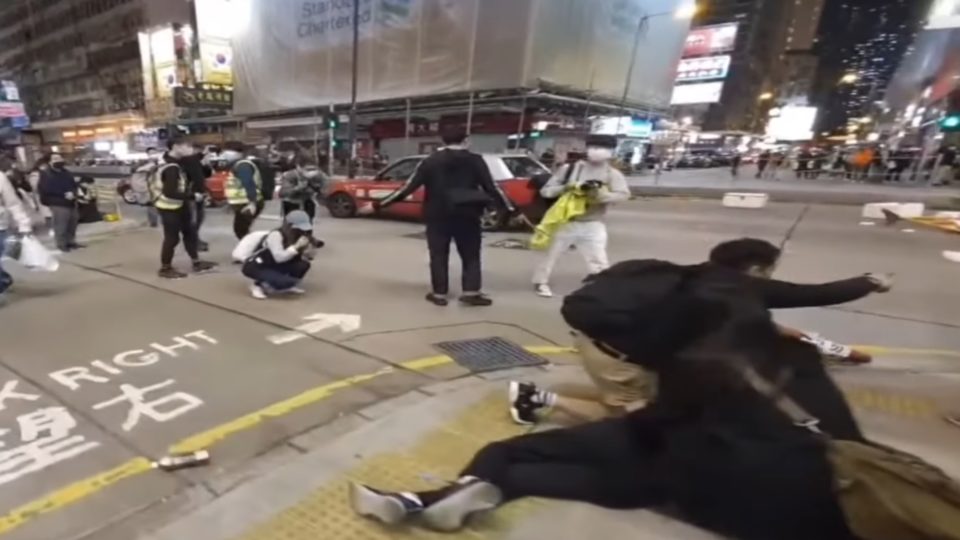Police descended on Tseung Kwan O, Sai Kung, Tai Po, and Fo Tan over the weekend to clear crowds of protesters who had gathered to voice their opposition to government plans to use nearby facilities as quarantine sites amid the ongoing coronavirus outbreak.
At around 8 pm on Saturday, hundreds of Tseung Kwan O residents gathered to protest against a proposal to set up a clinic to admit patients of the Wuhan coronavirus, according to Ming Pao. The protest was also mark the three-month anniversary of the death of student who died after a fall in the area during the anti-government protests last year.
As of 10pm, black bloc protesters were putting blocking the junction between Tong Ming Road and Tong Tsun Road with traffic cones, chairs, bicycles, and debris.
Shortly thereafter, riot police moved in to clear the crowd, detaining several people and firing pepper spray at journalists, district councillors, and onlookers. By 10.30 pm, the police had fired at least two canisters of tear gas as some citizens hurled debris at a police vehicle. Some 60 people were arrested over the demonstration.
Yesterday afternoon, hundreds of protesters began marching in downtown Sai Kung after a speech the night before in which Chief Executive Carrie Lam announced that the Sai Kung Outdoor Recreation Center — close to the residential area in the district — would be used for quarantine purposes, Ming Pao reports.
The SAR government said in a statement released on Sunday that it is actively searching for more potential sites for quarantine purposes, as three quarantine centers in Sai Kung — the MacLehose Holiday Village, the Lei Yue Mun Park and Holiday Village, and the Po Leung Kuk Jockey Club Pak Tam Chung Holiday Camp — were nearing maximum capacity. Of the 97 units at the three quarantine centers, 86 were reportedly occupied as of Sunday morning.
At about 2:50 pm, about 30 riot police moved to clear the marchers as they arrived at Tsui Tong Road. Police later hoisted a blue flag, warning they would use force against people who were unwilling to disperse.
Some participants of the march sustained injuries when police moved in to clear the crowd. Officers could be seen intercepting at least 40 people and arresting at least one man, who was knocked out by a baton blow.
Meanwhile, at about 2pm, around 200 protesters gathered in Tai Po to march against the government’s plan to admit patients under observation with fever and upper respiratory tract infection — symptoms of the coronavirus — into the district’s Tai Po Jockey Club General Out-Patient Clinic.
At around 4pm, some protesters began building roadblocks with dumpsters and debris on Kwong Fuk Road, temporarily disrupting traffic.
Later that evening, at around 7pm, another protest erupted in Fo Tan due to local opposition to the government’s revival of a plan to use newly-completed public housing estates as quarantine centers. The protest broke out after health officials, including Undersecretary for Health Chui Tak-yi, met with district councillors to discuss the use of the Chun Yeung Estate to house people who have been in contact with coronavirus patients.
Some councilors attempted to stop officials from leaving after being disappointed by the outcome of their meeting. A group blocked streets nearby until riot police moved in to break up the demonstration, RTHK reports.
Protesters gathered in Fo Tan again early this morning ahead of another meeting between district councillors and government officials today.
The government announced last month that such plans had been withdrawn amid public backlash, but it confirmed on Saturday the plan was back on as existing quarantine facilities at different holiday camps were full, with the Chun Yeung Estate earmarked for use as it can provide several hundred units.
The protests on Sunday came after similar demonstrations erupted in Mei Foo and Fanling in recent weeks, with protesters in Fanling going so far as to torch the lobby of newly completed housing estate slated for use as a quarantine site.
The government has said it must ensure the SAR had sufficient quarantine facilities, and emphasized that those to be held in the facilities were only those who had contact with patients, not confirmed or suspected cases.




